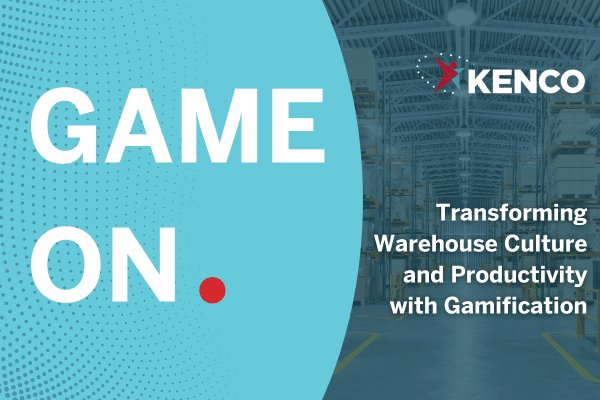Games at work? Sounds too good to be true! The truth is, we’re seeing it already.
Games at work? Sounds too good to be true! The truth is, we’re seeing it already. Top companies like Microsoft, Domino’s, Deloitte, and more have been leveraging gamification for years to engage employees and improve productivity. But what about in a warehouse setting? As it turns out, warehouses are the perfect environments to incorporate gamification strategies for many reasons, including the repetitive nature of the work, a data-driven culture, and the opportunities to cross-train and teach employees new skills.
What is Gamification?
Gamification applies game-design elements and principles in non-game contexts for the purpose of engaging participants and driving desired behaviors. As participants interact with the gamification program, they receive immediate feedback on their performance, as well as next steps towards new goals or achievements.
Individualized vs. Team-Based Gamification
Most gamification strategies in the workplace focus on the performance of the individual and their contribution toward a goal. While Kenco still implements individualized gamification strategies, we have also begun to adopt a new approach in the form of team-based gamification.
Kristi Montgomery, VP of Innovation, Research and Development at Kenco, shares her perspective, “We’re starting to take a different look at it because we feel like there’s an opportunity to leverage peer coaching and a peer network that hasn’t been tapped into before. For example, say you and I are working on a team together. If you’re falling behind or don’t understand how to do your job, I’m going to step up as your peer and help you figure that out because I want our team to be successful.”
Why Should Warehouses Incorporate Gamification?
Gamification strategies have the opportunity to improve warehouse performance, culture, safety, and efficiency.
Improving Employee Engagement
Labor shortages continue to challenge warehouses across the nation. As a result, many warehouses have turned to gamification as a means of attracting and retaining newer, younger workforces. A 2024 Lucas Systems study polling 750 U.S. and UK on-floor warehouse workers found that nearly 84% of respondents said they were more likely to stay with a company that developed workplace competitions around their day-to-day tasks. Team-based approaches to gamification can increase employee engagement and retention by offering opportunities to collaborate and connect with coworkers. These opportunities can help build and nurture both professional and personal relationships.
Driving Better Quality and Performance
When employees are able to visualize and measure their own performance against a standard, a goal, or even relative to other employees, they’re more driven to succeed. In Kenco’s warehouses that have implemented gamification, we’ve seen productivity improvements in the 3-5% range compared to our sites without real-time visibility into performance.
Finding Efficiencies Through Team-Based Gamification
Team-based approaches have the opportunity to leverage peer coaching and even reduce direct labor costs. When coworkers are working towards the same goal, they’re incentivized to help train and support one another. This could potentially mean the need for fewer supervisors and managers to look after a team of associates, reducing the facility’s labor costs.
Reinforcing Safety Measures
It’s not always about speed when it comes to gamifying warehouses and improving performance—safety is extremely important. Many warehouses today have incorporated gamified training modules and programs aimed at improving safety awareness. At Kenco, we provide opportunities to give kudos, or “spotlights” to employees for encouraging safe behavior via our mobile operator platform. Employees can earn awards and badges for receiving or giving spotlights, and have their certificates displayed in public areas of the warehouse.
What aspects of a warehouse can be gamified?
There are opportunities to gamify and improve operations around every corner in a warehouse. Here are a few areas where gamification can be applied:
Order Picking & Packing
Warehouses can implement gamification to improve fulfillment throughput by rewarding accuracy and speed. At Amazon, workers earn digital currency that can be redeemed for prizes by picking items from shelves and dropping them into bins.
Inventory Management
Rewarding employees for maintaining optimal inventory levels or completing cycle counts accurately and on time are a couple ways warehouses can use gamification to track and manage inventory.
Equipment Use & Maintenance
Allowing employees to earn points for using equipment properly, quickly reporting issues, or completing maintenance checklists can help extend the lifespan of material-handling equipment, forklifts, and other expensive equipment.
Employee Onboarding & Training
Gamification can be used as a way to onboard new employees and train existing ones with interactive quizzes and simulations.
Continuous Improvement & Innovation
Not only can gamification be applied to operational aspects of a warehouse, it can also be used to encourage new ideas. For example, at Kenco, we run an “Idea Challenge” across all of our employees to source ideas for overcoming specific work-related challenges. Ideas get upvoted by other employees and the ones with the most votes receive a prize for their creative contributions. Additionally, top ideas also have the opportunity to be implemented in our warehouses.
Read the eBook
To learn more about how Kenco has implemented gamification in our warehouses, read our latest eBook.

